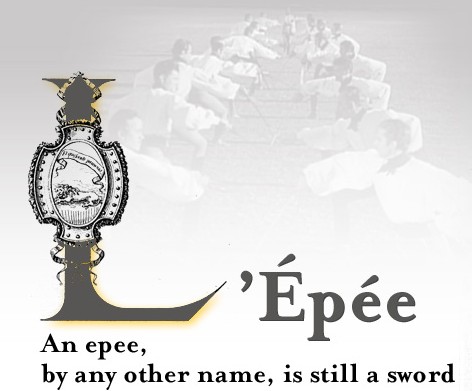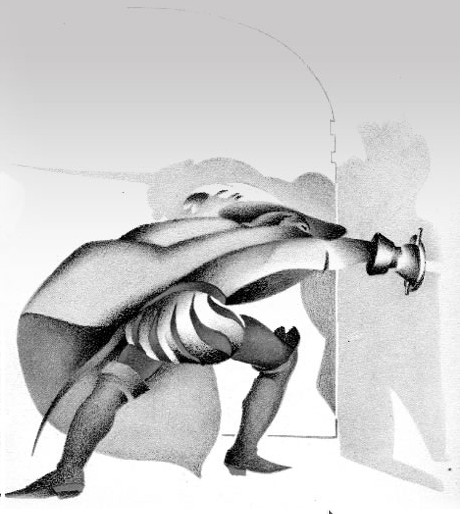
Definition
Epee, epée or épée , n . 1. A rapier with a three-sided blade and a sharpened tip (when used in the sport of fencing, there is a guard over the tip). 2. French word for sword (from the Middle French épée ). (From the Latin spatha , referring to a broad sword, by assimilation with spatha , a weaver's tool.
Greek: spathé , meaning blade; probably from spaô , I spread; compare with the Latin spatium or Sanskrit sphay : to increase, augment from the primitive root spâ, span or pan , meaning to spread and later applied, with a number of Aryan derivatives, to the work of weaving. See also the similarity with the English spade .)
Rapier , n. First, a long, double-edged sword of the sixteenth and seventeenth centuries, then a small, narrow-bladed sword, especially of the eighteenth century. From Middle French, rapiere , referring to the rasping of a sword.
Spade : 1. As a noun , a tool for digging, with a long, narrow blade that can be driven into the ground with the foot. 2. As a verb : to dig, cut or remove (using a spade). We find the Old English spadu , as well as the Celtic spad , or again the Italian spada (originally plural for sword). Other possible origins include the Old English and Irish spode and spadaim , meaning to strike down or kill. According to some, spatha was the name of the long sword carried by the Gauls and that the origin of this word was Celtic rather than Latin, the similarity with the Latin word spatha –weaving tool—considered as a mere coincidence. Bochart, in his book on Phoenician colonies, points to a link between the Gallic word spatha and the Hebrew sbat (plural: sbatim ), meaning baton, or the Chaldean sbatin . According to him, the original meaning was an iron baton, then sword. (This last etymology is doubtful.)
Sword , n . A weapon consisting of a long, sharp blade affixed to a hilt or handle, from Old English sweord , Old High German swert , Old Norse sverth .
When a man is on the field, a mediocre ability in the art of fencing exposes him to the danger of his enemy's sword more than it protects him. (Jean-Jacques Rousseau.)
The first thrust of your sword is superior to any of mine. (Corneille.)
By extension:
In a military sense :
Gens d'épée, noblesse d'épée homme d'épée all designate soldiers of the aristocracy. Notice the link between noble birth and the wearing of a sword.
To designate a warrior or general: The minister of war was called an illustrious epée.
To designate someone talented in the art of fencing: You are such a valiant man and such a fine epée… (Alexander Dumas.)
In a figurative sense:
--Military expeditions, combat, war: to perish by the sword
--Courage, military valor: Without a sign, his sword the brave man draws, and asks no omen but his country's cause. (Homer, The Iliad .)
--Armed rescue: Do you not know that among the Spanish it is an offense not to rush to a friend's aid, either with one's purse or with one's sword, when asked? (Le Sage.)
--Means of attack or defense: Right is the sword of the great, duty is the buckler of the small. (Lacordaire.)
--Force, power: He who bears the sword is the natural enemy of liberty. The sword accords a veritable right. (Pascal.)
A history of the sword in Europe
(Extracts from the Grand Larousse universel dictionary of the nineteenth century.)
Gallic soldiers wore their swords suspended from an iron or copper chain or a large baldric, and Titus Livius tells us that the Roman legions did not gain the upper hand until they were given the Spanish sword, equipped with a blade that was short, straight, wide and flat. The sword conserved the same form later under the Franks. We read in the Gesta Francorum (chapter XLI) and in the Gesta Dagoberti (chapter XV) that youths were enrolled as soldiers when their height was equal to that of a spatha (epée). In the same annals, the Frankish kings ordered decapitated all prisoners of war whose height exceeded the length of their swords. Poets have given rather peculiar names to the swords carried by the most famous heroes of the middle ages: Charlemagne's sword was called Joyful , that of King Arthur, Excalibur ; that of Roland, Durandal , etc.
The two-handed sword, or espadon , was a large, long weapon that one spun rapidly in circles in order to protect oneself while at that same time threatening one's adversary. These rather long and heavy swords were used for a long time. It is said that Godfrey de Bouillon split a man in two with just two blows from his sword; and the account of the liberation of Jerusalem is full of such anecdotes. Father Daniel sees nothing strange here, considering the strength of men of that epoch and the weight of the swords they handled, albeit with a certain agility. A sword preserved in Meaux and said to have belonged to Ogier the Dane is more than three feet long by three inches wide and weighs five pounds. Later, as defensive weapons became more resistant, shorter swords were adopted with just one cutting edge.
(…)The Germans carried swords that had never been seen before: they were long, thin, spindly, and double-edged, from the tip to the hilt. The fashion of long swords seems to be very old in France , and it is true that we can see them depicted in the fresco of a church in Angers , which represented a battle scene in 845 and is referred to by Father Daniel. At the epoch of Saint Louis , the sword's dimensions remained unchanged. That of a marshal of France had a blade of around two feet in length and was double-edged. One can read in a narrative of the battle of Bénévent, where Charles of Anjou, brother of Louis IX, defies his adversary Manfred: “The Germans fought with long swords, axes and hammers, keeping a sword's distance between [themselves] and their enemies; but our Frenchmen engaged them as closely as the nail is close to the skin and pierced them with their short epées.” Guillaume de Nangis, describing the same battle, uses nearly identical terms and also speaks of small, pointed epées with which the French struck those enemies not wearing armor. This weapon was not lengthened until the epoch that full iron armor replaced chain mail.
During the permanent state of war and troubles that reigned in France , the sword remained first among offensive arms, while the helmet was first among defensive arms. [The sword] was viewed, during the first period of chivalry, as the principal arm of honor; and even when those knighted by the king entered into conflict with gentlemen of noble blood, it served to distinguish the feudal nobility from the noblesse de robe. Constables carried their swords unsheathed before them in the presence of the kings; the grand equerry carried his sheathed; finally, during the coronation ceremony, it was posed on the altar from whence the prince came to take it, as a sign that he reigned by God's grace. Only the gentleman could wear [the sword] in all occasions. The serfs were not authorized to use it except to defend their lord's property; otherwise, their sword was condemned to rust in its sheath (…)
During the fourteenth century, the weapon that concerns us had different names: espadon or estocade, flamart, braquemart .
During the reign of Louis XIII, the fencing epée was adopted. This type offered a wide variety of forms: and so, there were epées à pistolet , in the form of a coquille, with cross-shaped guard, basket or grill-type guard, à miséricorde , half-cross, etc. There were others that were spatula-shaped, flamboyant, Spanish-style, Swiss-style, etc. It was also during the seventeenth century that carrying a sword in all occasions and in all places became the rage among diverse social classes. Under Louis XIV, vagabonds and even servants were armed with it; indeed, murders multiplied in the streets of Paris at an alarming rate, and it took many an act of parliament and many a royal decree to put a stop to this disorder. In 1666, notably, an edict forbade wearing a sword in the streets upon pain of a fine of 200 pounds, unless one was a gentleman, an officer of the king's house, a member of the regular troops or companies, a soldier of the guards, whether French or Swiss, or a royal officer charged with administering justice. Any other individual not covered by these exceptions had to hand his sword over to his host upon entering the city. These regulations were rather poorly observed. Civilians continued to carry their sword, and this state of confusion lasted until 1789. During that epoch, the regiment of the French Guards was the only military body that conserved [the sword]; it had not been worn by the regular infantry since the war of 1756. From the death of Louis XIV until 1815, dress swords had thin, flared blades; they were called carlets . Since that time, the carlets have been replaced by flat swords. The artillery museum of Paris and the museum of Cluny have in their possession a number of swords having belonged to well-known people. The flamard of Louis XI is remarkable for a singularity that characterizes this prince: on both sides is engraved the Ave Maria . The sword that François I carried at the battle of Pavie has a hilt in the form of a cross, studded with golden ornaments, of which we can even distinguish salamanders; on the guard, one can read in enameled letters this passage from Scripture: Fecit potentiam in bracho suo ; this weapon was conserved in Madrid, in the same room where the king had been held prisoner. In 1808, Murat, after entering the Spanish capital, had the relic solemnly transported to the palace occupied by the French general staff, and then sent it back to France . The sword that Henry IV wore on the day of his marriage to Marie Medici, offers a rich, damask blade studded with inscriptions referring to the king's victories against the League; the sheath is encrusted with medallions in mother-of-pearl, upon which are engraved the twelve signs of the zodiac.
The epée is essentially a weapon d'estoc , that is, destined to pierce; but it is sometimes given a form that permits one to use it as a weapon for striking with the sharp edge.
Since the Revolution, in particular in the last forty years, [the sword] is no longer worn, at least in France, except by certain categories of civil servants in ceremonial dress and, in the army, by general officers and by the officers and sub-officers in certain special corps; but for the former as well as for the latter, it is only a simple parade weapon.
Different swords and associated expressions
- Two-handed sword or epée : A very long and heavy sword used in the Middle Ages, the hilt of which one handled with two hands.
- Double-edged sword : A sword with two cutting edges, with which one can either thrust with the tip or strike with the sharp edge. In English and French, also an expression signifying an act or remark that can have an opposite effect or interpretation: Every conspiracy is a double-edged sword. Every sword has two edges; he who wounds with one edge wounds himself with the other. (Victor Hugo.)
- Sword of State : The sword that is carried before the sovereign of Great Britain during ceremonies and processions.
- To cross swords with someone is to engage someone in combat or to argue violently with someone: Management and labor representatives crossed swords over the issue of salary increases .
- To beat swords into ploughshares is to disarm or to convert from a militaristic economy to a peacetime one: They shall beat their swords into ploughshares, and their spears into pruning-hooks; nation shall not lift up sword against nation, neither shall they learn war anymore. ( The Bible, Isaiah 2:4 .)
-When a sword of Damocles hangs over someone's head , it means that something bad and inevitable will happen to that person very soon: Living with a deadly virus is living with a sword of Damocles hanging over one's head .
-The flat of the sword is the flat part of the blade.
-To draw one's sword is to pull the sword out of its sheath, hence to declare war or hostile intention: During the Cuban Missile Crisis, diplomatic relations between the United States and the Soviet Union were very tense; either party could have drawn their sword at any moment.
-To sheath one's sword is to end a combat or a war.
-When an officer surrenders his sword , he recognizes his defeat or makes himself a prisoner of war: When Cornwallis surrendered at the Battle of Yorktown , he surrendered his sword to General Washington.
-To fall on one's sword is to sacrifice oneself: The boss will have to dismiss me if he wants me to leave; I'm not going to fall on my sword!
-To have only cape and sword : was said of poor gentlemen, and notably second-born sons of the nobility, who had to take up the soldier's trade.
- Cape and sword, or cape and epée, novel is the name for a swashbuckler in France and Latin countries, which presents courageous and chivalric heroes.
-To perish by the sword is to be a victim of military aggression, especially war.
-To put to the sword is to slay or execute someone.
Proverbs
- He who lives by the sword shall perish by the sword (The Bible: Matthew 26:2) : Anyone who uses violence to achieve his ends will also become a victim of violence.
- The pen is mightier than the sword : Being good with words is more useful than being an able fighter.

